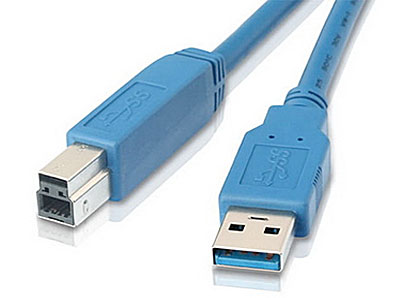
หลายๆ ท่านน่าจะรู้จักกับเทคโนโลยีการโอนถ่ายข้อมูลใหม่ที่ชื่อว่า Thunderbolt และ USB 3.0 กันมาบ้างแล้ว และรู้หรือเปล่าครับว่าทั้งสองอย่างนั้นต่างกันยังไง วันนี้ผมมีคำตอบครับ

คงต้องท้าวความกันนิดครับว่า Thunderbolt เนี้ย คือการพัฒนาความร่วมมือกัน ระหว่าง Intel กับ Apple เพื่อสร้างพอร์ตสำหรับการเชื่อมต่อ โอนถ่ายข้อมูล ที่มีความเร็วสูง ซึ่ง Thunderbolt นั้นมันมีความสามารถในการโอนถ่ายข้อมูลได้สูงสุดถึง 10 Gbps. ต่อวินาทีเลยทีเดียว นับว่าสูงมาก โดยในปัจจุบันนี้ มีเพียง Mac Book Pro เท่านั้่นที่นำเทคโนโลยีนี้มาใช้ (แต่ตอนนี้กำลังมีหลายๆ เจ้าเลยที่กำลังพิจารณาเอามันมาใช้กับผลิตภัณฑ์ของตัวเอง) นอกจากนี้แนวทางการพัฒนายังสามารถเข้ามาแทนเทคโนโลยีการโอนถ่ายข้อมูลความ เร็วสูงของฮาร์ดดิสและแทนพอร์ตที่ใช้เชื่อมต่ออุปกรณ์ด้านต่างๆ ที่สำคัญมันยังถูกออกแบบมาให้สามารถแทนที่พอร์ตเดิม ๆ อย่างพอร์ต USB, PCI-Express, SCSI, FireWire,SATA ในอนาคตด้วย

ที่นี้เราลองมาทำความรู้จักกับ USB 3.0 กันบ้าง สำหรับ USB หรือ Universal Serial Bus ได้รับการยอมรับอย่างเป็นทางการจากสื่อต่างๆ ว่าเป็นมาตรฐานใหม่ในปี ค.ศ. 1998 ตอนนั้นเริ่มต้นที่เวอร์ชั่น 1.1 ครับ โดยมีความเร็วในการแลกเปลียนข้อมูลสูงสุด 12 Mbps แล้วหลังจากนั้นก็มีการพัฒนาการมาเรื่อยๆ จนล่าสุดนี้มีการเปิดตัว USB 3.0 ให้เห็นกันเมื่อปีค.ศ. 2007 ที่ผ่านมา ความเร็วในการเชื่อมต่อและการโอนถ่ายข้อมูลของ USB 3.0 นั้นอยู่ที่ 5 Gbps. ต่อวินาทีครับ ซึ่งเมื่อเทียบกับ USB 2.0 ที่มีการใช้งานกันอย่างแพร่หลายมากที่สุด ในปัจจุบันมีความเร็วเพียง 280 Mps. เท่านั้น จะเห็นว่า 3.0 เร็วกว่า 2.0 กว่า 10 เท่าตัวทีเดียว ปัจจุบันนี้เราก็มี USB3.0 ในอุปกรณ์ต่างๆ มากมายที่เลือกเอามาใช้งาน

คราวนี้เมื่อรู้จักกับเจ้าสองพอร์ตคราวๆ กันแล้ว เราก็ลองมาดูประเด็นที่ว่าแล้ว ระหว่าง Thunderbolt กับ USB 3.0 อันไหนดีที่เราจะเลือก ผมสรุปมาได้คราวๆ ประมาณนี้
- พอร์ต Thunderbolt ตอนนี้นอกจาก Macbook Pro แล้วยังไม่มีโน๊ตบุ๊คตัวใดมี (แต่ในอนาคตอันใกล้น่าจะเพิ่มขึ้นได้ไม่ยากนัก)
- Thunderbolt Controller ผลิตโดย Intel เจ้าเดียวเท่านั้น ไม่เหมือนพอร์ต USB ที่บริษัทอื่นผลิต Controller ของตัวเองได้โดยง่าย
- มีอุปกรณ์อื่น ๆ เช่น External Hard Drive หรือ Monitor ในตลาดรองรับ Thunderbolt น้อยมาก ที่มี Hard Drive จาก LaCie เพียงหนึ่งตัว ข้อสังเกตเพิ่มก็คือ มี Western Digital ผู้ผลิตฮาร์ดดิสรายใหญ่อยู่ในส่วน 'Industry Support' ในเว็บของ Intel ด้วย
- จากข้อสองทำให้ราคาของอุปกรณ์ที่รองรับ Thunderbolt "ไม่น่าจะมีราคาถูก"
- ยังไม่มีตัวแปลงพอร์ตอย่างเช่น DVI to D-sub
- Intel มีแผนจะรองรับ USB 3.0 ในอนาคตด้วยเช่นกัน (ซึ่งแสดงว่าก็ยังไม่หยุดการพัฒนาไปโดยเด็ดขาดแน่นอน)
- และนอกจาก Intel แล้วยังมีบริษัทอื่นที่มี USB 3.0 Controller ของตัวเองอยู่แล้ว และ USB 3.0 ยัง Compatible กับอุปกรณ์ USB 2.0 ได้ด้วย เช่น Flash Drive ซึ่งใช้งานกันอย่างแพร่หลายในปัจจุบัน
- ผู้ใช้ทั่วไป อาทิเช่นการถ่ายโอนข้อมูลงานทั่วไปหรือใช้งานทั่วไป อาจจะไม่ต้องการความเร็วขนาด (Thunderbolt)

สรุป อย่างง่ายๆ ก็คือว่า Thunderbolt นั้นเหมาะมากสำหรับการเสริมทัพเทคโนโลยีในการเชื่อมต่อ โอนถ่ายข้อมูลที่กำลังจะมาถึงในอนาคตครับ เพราะว่าในปัจจุบันนี้ หาการเชื่อมต่อที่เข้ากันของอุปกรณ์ได้ยากอยู่พอสมควร ส่วน USB 3.0 นั้นถือว่าเป็นสิ่งที่น่ามองมากกว่าสำหรับเทคโนโลยีที่เราต้องปฎิสัมพันธ์ กับอุปกรณ์ 99% หรือกลุ่มผู้ใช้ส่วนใหญ่ในสังคมโลก ได้ดีกว่า เพียงแค่ มันสามารถเชื่อมต่อกันได้ระหว่าง USB ด้วยกันก็เจ๋งแล้ว แต่ในขณะเดียวกันที่ Thunderbolt ยังทำไม่ได้ แต่สำหรับในอนาคตนั้น คาดกันว่า พอร์ตแบบ Thunderbolt น่าจะได้รับความนิยมแน่นอน โดยเฉพาะจากฝั่งผู้ใช้ mac